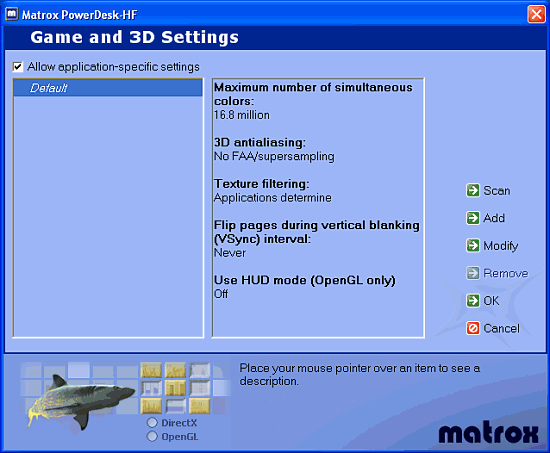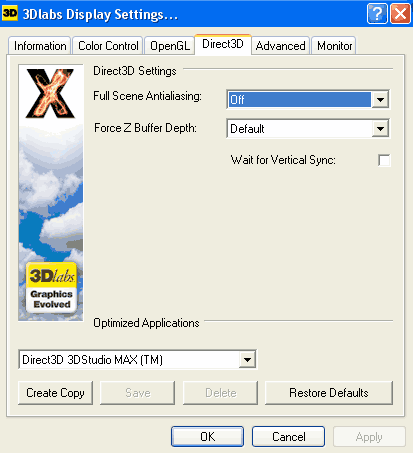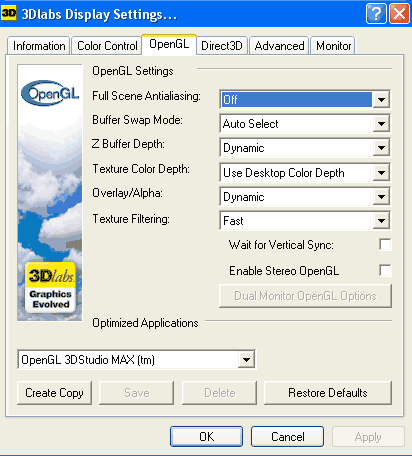 |
||
|
||
| ||
This time we have a chance to test professional video accelerators on a dual-processor system. I have chosen the most powerful and promising video cards available in our lab. The test program is 3ds max from Discreet of the new fifth version. I won't dwell on the changes because those who are interested in this packet are aware of them. Besides, the today's aim is not a comparison of the 3ds max versions or looking for advantages and disadvantages of this system. In the new 3ds max version Discreet recommends new benchmark scenes. I didn't involve them because the scenes we used before do not differ much from the newer ones. Although they don't look the same outwardly, their insides are similar. Besides, if I replaced them, our base with results of the previous tests wouldn't be useful anymore. And I can trace the evolution of both the system and professional accelerators. It's possible that I will use new scenes in the future in order to expand the test scenes. Nevertheless, whether we will use the new scenes or not will depend on many factors. Test platformThe test platform is a full-size workstation which is quite noisy when voltage is supplied to the fans. However, it doesn't tell badly upon operation of the system. Mostly, it gets on the operator's nerves :). So, the platform consists of:
Cards:
Besides, we pumped through the tests such gaming cards as GeForce 4 MX 440, GeForce 4 Ti 4600 and Radeon 9700 Pro. Drivers:
In the driver's settings the 3ds max optimization when available. Below are the screenshots of some settings both in the card's drivers and in the 3ds max settings. First of all, the 3ds max:   The special drivers' settings: from ATI:       The other settings are quite simple; just note that in all cases the vertical sync mode was off and 3ds max optimization was enabled. Note that the gaming cards which were tested along with the professional solutions are what the professional cards are based on. No secret that a manufacturer first makes a gaming chip and then improves it physically or on the driver level to get a professional card. That is why the game accelerators were included as well. The tests were run under the Windows XP professional coupled with the service pack 1 and all necessary drivers. After that we installed drivers of a tested video card and then the 3ds max. 3ds max 5 TestsIn this review I do not touch upon the differences of the 3ds max versions. That is why the testing technique we used for the professional accelerators in the 3ds max 4 is suitable for the 3ds max 5. However, there are slight alterations. As we found out that operation in the Direct 3D 3ds max greatly depends on a central processor, I didn't test the cards with this API long. This time the processor has a different effect, at least because there are two processors. Both are quite mighty not to limit the professional accelerators much. That is why we will carefully test operation of the cards under the Direct 3D (further I will call it just D3D). Certainly, the OpenGL (further OGL) is the main API in operation of the 3ds max. That is why the conclusion will be based mostly on the scores achieved with this API. It's also interesting to check an API written by a manufacturer for a certain card. It's assumed that such API uncovers entirely card's capabilities. Strictly speaking, we shouldn't collate the cards working with their own APIs as they use different modes and have different extension sets of basic functions. But I will comment on performance of a given card working with a given API in given conditions because the potential can be revealed only in certain conditions. Impression of the operationIf you remember our testing technique, one of the key conclusions is that of the operator, i.e. his or her own impressions. Unfortunately, today I can't share all the thoughts that came into my mind. Let me explain why. Imagine that test scenes are loaded and tested in the real conditions. I describe my impressions and move on to the qualitative tests. I make screenshots and try to find bugs. Then I turn to the quantitative tests and get some figures. Sometimes they differ much from what I feel. For example, it seems to me that operation of a certain scene is hindered by something, but the quantitative tests give around 300 FPS. It's much, and it shouldn't influence my impressions. I'm not very quick to catch the difference in operation. Nevertheless, it's a paradox. That is why don't accuse me, I'm just describing my own impressions. The Demo01 in the OGL proved to be fast and convenient for operations of scaling, rotation and moving of objects, the whole scene and the camera. The Demo02 in the OGL works efficiently as well. It's not so jerky anymore as we could see on one processor. The Demo03 in the OGL runs noticeably faster than with just a single processor. However, it doesn't relate to the Matrox Parhelia. This card redrew jerkily even the demo01 with four active viewport windows, though the weaker cards coped better with this scene. The scenes under the D3D are again simpler in handling compared to the uni-processor system. But in this API all scenes except the demo01 work seemingly slower than in the OGL API. It relates to all the cards. The D3D is certainly not a native API for the 3ds max though it's supported. And I can understand it because professional accelerators are initially developed for the OGL and its different extensions. Under their own APIs (special driver, or simply SD) the situation is much more pleasing. The demo01 runs fast, as expected; and the demo02 and demo03 perform markedly faster than in the uni-processor system and the dual-processor one controlled by the OGL. Well, it's logical as the native API knows well all peculiarities of its card. I have left all the errors and SDs for the end just not to worsen the impression before the quantitative results. ;-) Especially because there is a small revolution, to a;; appearances, right around the corner. Quantitative resultsThis section has nothing to do with my subjective estimation. NVIDIA takes the lead. Its most powerful and expensive cards of both the professional and game markets are above all. Look at the connection between the professional and game accelerators. Do the GeForce 4 Ti 4600 and Quadro 900/980 differ much? And what about the GeForce 4 MX 440 and Quadro 4 550? It's also interesting that the ATI's cards FireGL 8700 and FireGL 8800 show such different scores, though the FireGL8700 has only twice less memory compared to the FireGL8800 and a bit lower frequencies. Obviously, ATI realizes it, and the prices the professional FireGL8800 or FireGL8700 are selling today at are very attractive. ;-) Note also that the Matrox card is the last in this round. NVIDIA sticks to the first position. And the ATI's cards show the most verisimilar results. The Matrox falls into the last place. In this test quality becomes more important than speed. The completely different cards of NVIDIA are approximately on the same level which means that some OpenGL functions are not elaborate. Well, ATI has it even worse, and its cards are at the end. The Parhelia of Matrox and Wildcat VP870 of 3Dlabs keep to the middle. The VP870 shines in this test, thanks to driver's setting which allows to set the geometry or texturing mode. That is why it was expected that this card would be the first in the geometry test. The rest of the cards go almost shoulder to shoulder, except the Parhelia. Geometry can be different. It's enough to reload a scene with a great number of geometrical figures to change the results dramatically. The NVIDIA's cards have better lighting, though it's not easy to beat the ATI's flagship which takes the top position in the Light2 test. The VP 870 copes with its task perfectly as well. I just don't understand why the FireGL 8700 looks so bad compared to its senior brother. This is the only test where the Parhelia comes with good scores. Although it yields to the Quadro 4 900/980 and GeForce 4 Ti 4600, it performs much better than before. As for the textures, the NVIDIA's cards have no equals. In the wireframe mode the NVIDIA Quadro 4 900 looks a tad better, but in general, all the cards have good scores in this mode. There is no an outstanding leader here. In the speed tests with AA the Matrox's card doesn't attract any attention at all. The other cards go in one line. Summary on the OpenGL APIThe new Quadro 4 980 line remains unwanted. It differs from the old Quadro 900 only in the AGP 8x mode supported. But with 128MB memory onboard this mode looks odd as there are no scenes with such a great number of textures. Besides, I think there are not many people who would work with all textures even if they are greater than 128 MB in their daily work, only maybe at the final rendering stage. The new Quadro 980 is almost as efficient as the Quadro 900, and the difference can be both positive and negative which looks like a measurement error. The father of these cards GeForce4 Ti 4600 scored good results close to the Quadro 4 9x0 series. Similarity of the results of the GeForce 4 MX 440 and Quadro 4 550 is logical as well. As for the Matrox Parhelia, this card doesn't use even a half of its capabilities. Well, if it cost 2-3 times less, it would look more attractive. The Wildcat VP870 showed good average capabilities. The behavior of the ATI's cards is very unpredictable. From the chip's standpoint everything looks OK. But the drivers' support of the chip is not so smooth. The failure in some tests and a big difference between similar cards in some others mean that ATI has much work to do. The drivers are still far imperfect. When we just started the tests on the dual-processor system we had the old drivers (30.36) where the 3ds max 5 worked unstably and bugly. In several days the company uploaded the new drivers which worked flawlessly with the new version of the 3ds max. It means that they are optimized for a definite application. On the one hand, it's excellent, but on the other hand, a user will have to look for new versions of the drivers in case he or she installs a new product. Direct 3DI won't look into each test separately. Instead, I will make a general conclusion after all the diagrams. At first glance, it's a kind of revolution, and everybody must turn to the D3D API right now. But let's investigate it. Let's start with the card which wasn't tested under the OpenGL API because of some technical problems. This is the latest gaming card, ATI Radeon 9700 Pro. Its performance is very attractive. At the same time, in this API its speed isn't so high. Well, it works but no so efficiently as the figures show. Besides, in many tests the demo scenes are displayed incorrectly. You will see it in the screenshots gallery which will be published a bit later than this article. Let's assume that the driver is debugged and everything works correctly, but then why doesn't the 3ds max even start on this card under the OGL? The driver is not or just partially debugged, i.e. only for the D3D. Today it's still hard to say for sure what's wrong with this card. In this API the Matrox Parhelia changes and climbs to the top. The reason is the driver optimization for the D3D. Unfortunately, the D3D is so seldom used for professional use in the 3ds max... The ATI FireGL8800 shows very surprising results, sometimes very high, sometimes very low. It's not because it's optimized for certain tests, but the driver just works incorrectly. There is nothing we can say about the anti-aliasing under the D3D because the zero on the diagram means that the AA didn't work at all. Apart from this card, a half of the rest didn't work in this mode under the D3D. The Wildcat VP870 keeps to the middle. It passed all tests easily and reliably. Stability of operation of the NVIDIA's cards is really pleasant. Their results correlate according to the market positions and classes of the cards. The proportions are retained which indicates that the D3D drivers of NVIDIA are much better than the others. Besides, as we expected, the D3D API depends on a processor. Even without the old tests on the uni-processor system we can see that the speed is noticeably higher compared to the tests in the OpenGL API. The second processor adds to the performance of all the cards. Special DriverAgain, let's first look at all the diagrams and then make a conclusion. This mode will help us dot all "i's" and cross all "t's", because it is a special driver which must uncover the whole potential of a card. Well, it's clear that the Quadro 900 and Quadro 980 lines are better. They are the speediest in almost all the tests, as it was expected. But I didn't expected the 3Dlabs Wildcat VP 870 in the second position. Well, the developers managed to make a driver which squeezes this cat entirely. But remember that we used just a beta version, and it's possible that by the official release the driver will be improved even more. Well, it will be a good competition for NVIDIA. ;-) On the one hand, the low scores of the ATI's cards are offset by their low
prices; but on the other hand, various errors in the other
APIs imply that the special driver wasn't tested carefully
and it doesn't use all capabilities of the cards. There is
something we should think about: taking into account that
potential of a card must be revealed with its special driver,
and the figures obtained are not amazing, the potential mustn't
be high compared to the remaining cards. However, it mostly
concerns the FireGL 8700, as the FireGL 8800 tries to move
forward. But the final word is after you.
Alexander Kondakov (mailto:kondalex@ixbt.com)
Write a comment below. No registration needed!
|
Platform · Video · Multimedia · Mobile · Other || About us & Privacy policy · Twitter · Facebook Copyright © Byrds Research & Publishing, Ltd., 1997–2011. All rights reserved. |